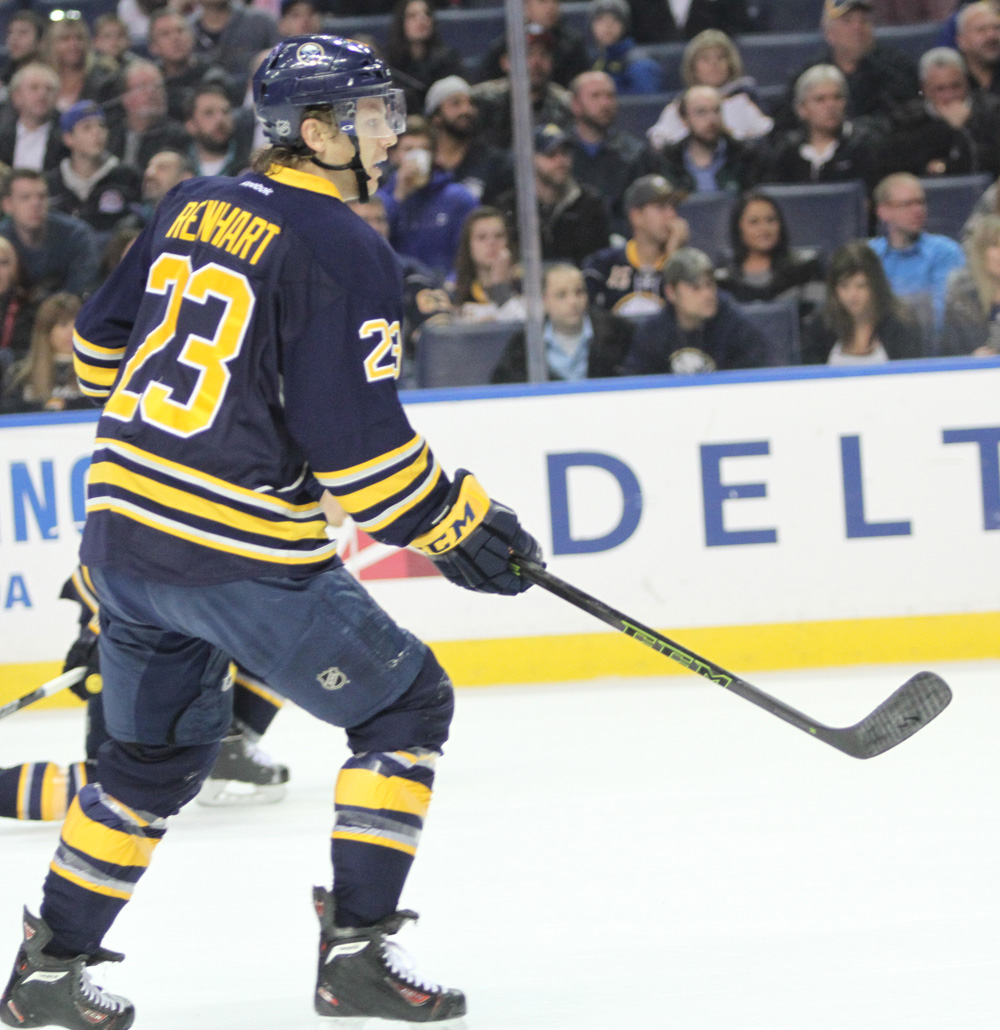By Jourdon LaBarber – Sabres.com (@JourdonLaBarber) – (Photo by Janet Schultz Photography) –
During the second period of a game in September, Randy Cunneyworth gave us a glimpse into the future. The newly hired coach of the Rochester Americans was behind the bench for an exhibition game on Sept. 14 between prospects from the Buffalo Sabres and the Boston Bruins, and his young Sabres squad was trailing 2-1.
So in an effort to make a game-winning push, Cunneyworth made a seemingly easy decision: He put his two best players on the same line. It was the first time that Jack Eichel and Sam Reinhart, former opponents on the international stage, ever shared a line, practice included.
Eichel assisted on Brycen Martin’s game-tying goal with 5:45 remaining with a slick pass through the slot. Reinhart, foreshadowing what was to come, had himself parked in front of the net.
The game ended with Eichel scoring a breathtaking, game-winning goal in overtime, and Reinhart was the first teammate there to embrace him in celebration.
Afterward, Cunneyworth called it a “natural pairing.”
After becoming linemates on March 1, Eichel and Reinhart combined for 29 points (12+17) in 19 games; 15 from Eichel (7+8) and 14 from Reinhart (5+9).
In some ways, it is. Reinhart and Eichel, after all, were each taken with the second overall pick in the NHL Draft – Reinhart in 2014 and Eichel in 2015 – and both carried the expectations that came with it. There was immediate off-ice chemistry between the two.
They were assigned as roommates first at Development Camp in July and then on road trips in the regular season. By the end of October, they were already discussing finding a more permanent living situation together.
But on the ice, the chemistry between the two rookies wasn’t all that natural at first. Sabres coach Dan Bylsma said he’d experiment putting them together despite the fact that both were drafted as centers, and it made sense – Eichel had the speed and playmaking; Reinhart had the intelligence to take advantage of those qualities.
Bylsma stayed true to his word and made them linemates for a game in Philadelphia on Oct. 27. It lasted only three games, and the lines were shifted.
“It took some time to kind of get used to each other and it took about half the year for us to move back together,” Reinhart. “Once we did, we felt more and more comfortable as time went on. That was important for us.”
When they finally did get back together, it was March and they became arguably the team’s most dynamic pairing. But before that happened, both players carved out individual roles as they navigated their way through their rookie seasons.
HOLIDAY VACATION
It was Christmastime, and Jack Eichel could use a break. He’d had a whirlwind of a year, finishing his freshman season at Boston University in April, playing at the IIHF World Championship in May and then beginning the draft process as one of the League’s most highly-touted prospects in June.
There was barely any time for him to rest over the summer, either, with Development Camp held in Buffalo in July and an early start to his first Training Camp as the Sabres hosted the inaugural Prospects Challenge in September.
When the Sabres’ six-day break for Christmas rolled around, Eichel had played in all 34 of the team’s games. In some respects he had lived up to his billing, with 16 points (9+7), including a number of highlight-reel goals that showcased his unique talent. But he hadn’t scored a goal in seven games.
He went home to North Chelmsford, Mass., to finally refresh with his family, if only for a few days. The Sabres’ first game following the break was in Boston against the Bruins on Dec. 26, so he was glad to be able to make the 40-minute drive to work that day and meet his teammates at TD Garden. It would be his first professional game in his hometown.
Eichel had a four-point night – his highest single-game total of the season – to lead a furious third-period comeback in a 6-4 win over the Bruins. He never looked back.
“I think I kind of took that turn after Christmas time,” Eichel said. “I started to take more ownership of my own game and take more responsibility and expect more of myself … A lot of ups and downs in an 82-game season, but I tried to find a consistency and be better night in and night out.”
Eichel would never attribute the improvement he’d show over the remainder of the season to that six-day break. Both he and Bylsma agreed that it was at least partially attributed to improved practice habits; he’d learned over his first three months how to better prepare at hockey’s highest level.
Whatever it was, the results were undeniable. In the remaining 48 games, Eichel’s points-per-game average nearly doubled, climbing from 0.47 before Christmas to 0.85 after. He became the first Sabres rookie to lead the team in goals (24) since Ray Sheppard in 1987-88.
“It’s been fascinating to watch him play throughout the year, to see how good he is, what his speed can do, what he can do to the other teams ” Bylsma said after Buffalo’s final game of the season. “When you look at the last half a season, you see a guy who has had the puck on his stick as much as or more than anybody in the League and shows that he can be a dominant player in doing that. I think that’s where he’s grown.”
A NEW ROLE
In the final practices leading into the season, it was unclear what exactly Sam Reinhart’s role was going to be. After nine games with Buffalo in 2014-15, he was assigned back to his junior team and told to keep working on his strength and conditioning and his skating. His season was great, but his summer was even better.
He was given the Craig Ramsay Award as the team’s hardest worker at Development Camp in July, but as the regular season neared, he found himself alternating with Johan Larsson as the third-line center in line rushes. Reporters asked him about potentially beginning the season in the American Hockey League.
Only when Brian Gionta sustained an injury that sidelined him to begin the season did it become clear to the outside world that Reinhart was going to play. He scored his first point of the season in Buffalo’s second game, at home against Tampa Bay on Oct. 10, and it was then that he gave a first look at his what would become his unlikely role on the team – Buffalo’s best net-front presence.
In that game against Tampa Bay, Reinhart stationed himself squarely in front of goalie Ben Bishop as Josh Gorges took a shot from the left faceoff circle. Reinhart tipped the shot off Bishop’s pad, creating a rebound off of which Nicolas Deslauriers would score Buffalo’s lone goal of the afternoon.
Reinhart had entered the season having never played the net-front. But by Oct. 16 – four games into the season –Bylsma was already crediting him as being one of the team’s most willing and able players at the position, and he moved him accordingly to the top line.
Over the course of the season, 14 of Reinhart’s 23 goals came from around the net. Four of those were tipped shots and four more were rebounds. He also created four assists at the net-front.
But what the numbers don’t show are the number of goals that were created by him simply screening the goaltender, which happened eight times. Seven of those came on the power play.
“There hasn’t been a year where I’ve been there as much as I have this year so I felt more and more comfortable,” Reinhart said. “Obviously I’ve been playing with some pretty good players and they’re going to get the puck there. I’ve learned to put that in my game.”
Reinhart scored his first NHL goal on Oct. 17 in Tampa Bay, his first game on the top line. That game gave him confidence, he said, and he carried it with him through the rest of the season. His shot famously improved from what Bylsma described as a “muffin” in Training Camp to a quality shot midway through the season. His points-per-game average increased from .39 in the first 40 games to .63 in the remaining 39.
By the time March rolled around, Reinhart had already wowed his general manager.
“If you just look at Sam, alone, from his nine games last year to now, that’s a major, major bump,” Tim Murray said at a press conference on Feb. 29. “I believe there are one or two more major bumps for him.”
COMING TOGETHER
When it was revealed on Feb. 21 that Ryan O’Reilly would miss 3-to-4 weeks with a foot injury, Reinhart was adamant that no one man could fills in his shoes. O’Reilly was the first one Bylsma called upon in all situations. He was their leader on the ice, not to mention their leader in scoring.
It would have been unfair to assume two rookies – Reinhart at 20 years old and Eichel at 19 – would pick up the slack. But another week went by and the Sabres lost another top-six forward, this time with the trade of Jamie McGinn to Anaheim. In a subsequent move, Eichel and Reinhart found themselves reunited on Buffalo’s top line.
It was a natural pairing.
After becoming linemates on March 1, Eichel and Reinhart combined for 29 points (12+17) in 19 games; 15 from Eichel (7+8) and 14 from Reinhart (5+9). They were both directly involved on seven of the team’s goals over that span, giving them 11 total connections on the season.
Finally, their chemistry off the ice had translated onto it.
“As soon as Ryan went out and I moved with Jack, I think we fed off each other a little bit,” Reinhart said. “As soon as the puck gets on my stick and vice versa as well, I’m looking for him. He’s going to get open. He’s going to be there to make the play and I think it goes both ways. We’re looking for each other now.”
They ended the season as the Sabres’ top two goal scorers, Eichel with 24 and Reinhart with 23. Their 5-on-5 stat lines were remarkably similar too. Reinhart scored 29 points (13+16) with 1.7 points-per-60 minutes; Eichel scored 29 points (12+17) with 1.5 points per 60.
All the while, that friendship they fostered early on continued to grow.
“I think it’s a special relationship,” Eichel said. “Sam and I are very good friends off the ice and we understand each other. I think usually that carries through to your performance on the ice – and in that case, I think it has.”
Together, Eichel and Reinhart became just the third pair of Sabres rookies to both score 20 goals in a season. You may have heard of the others: Danny Gare (31) and Peter McNab (22) were the last to do it in 1974-75 while Gilbert Perreault (38) and Steve Atkinson (20) both hit the mark in 1970-71.
Given that, it’s safe to say that both rookies have given both fans and the front office plenty to be optimistic about moving forward. After their torrid run through the final month of the season, the question simply becomes whether or not we’ll continue to see them improve as a pair on the ice.
Without making any promises, Bylsma said he’ll keep it in mind.
“I think they really kind of enjoy that, playing together and having that connection,” Bylsma said. “That one I have written down for next year.”
(Reprinted with permission of the Buffalo Sabres)







